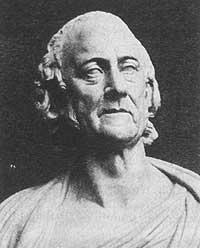Alessandro Volta
Italian physicist born in the kingdom of Lombardy in Como on 18 February 1745. As a child he did not learn to speak until he was four, so his relatives were concerned about mental retardation. When he was seven, however, he had reached the level of his friends and, thereafter, he learned faster than others.
In 1774 he was appointed professor of Physics at the Higher School of Como. He was concerned about the phenomenon of electricity that was fashionable at that time, due to the interest aroused by Priestley's new theories. The following year he invented the electroforum (static electricity generating apparatus) and described it in a letter to Priestley.

The electroforum consisted of an ebony coated disc and another metal disc with electrically insulated handles. Rub the ebonita disc and negative electric charge. If a metal disc is placed on it, which is zonal and parallel, a positive electric charge appears on the lower side of the metal disc and on the higher negative. The negative load on the ground can be dragged and the repetition of the cycle allows us to have a lot of load on the isolated handle disc. The electroforum is basically an electrical charge accumulation apparatus with the same base as the current capacitors. He discarded the Leyden bottle.
In 1778 he studied the composition and nature of the gas of the reservoirs (methane). Consequently, he invented the eudimeter used for volumetric analysis of gas mixtures.
In 1779 he was awarded a chair of physics at the University of Paris. There he also invented other appliances in static electricity.
In 1791, the Royal Society handed him the Copley medal for his works and later he was appointed a member of it.
Later he was in charge of the tests carried out by Galvani. If two metal pieces appeared when touching the muscle, the origin could be in the muscle or metal part. To prove this, in 1794 he achieved an electric current using only metals without muscle. Therefore, the electric current had nothing to do with live muscles or tissues. As a result of this discovery, Volta and Galvani argue. Two groups were then formed, the German Humboldt in favor of Galvani and the French Coulomb in favor of Volta.
In 1800 he invented a device capable of generating electric current. He used saline containers. The metal arches placed one tip in one container and the other in the other. One end of the arch was copper and the other end of tin. It was the first battery ever.
Volta abandoned the size and drawbacks of dissolved containers with small copper and zinc discs and carbon discs impregnated in intermediate saline solution. Copper, zinc, coal, copper, zinc, coal, etc. his discs overlap. Connecting with a wire the bottom of the first disk and the top of the last, passed the electric current. Therefore, Volta's stack was invented. As the discs were placed next to the song to perform a job, it was also called electric battery.
Invented the electric battery, Volta's fame spread all over the world. Emperor Napoleon also called him in 1801 to be taught his inventions and gadgets in Paris. The emperor appointed him Count and Senator of the Kingdom of Lombardy. In 1815 the Austrian emperor appointed him director of the faculty of philosophy of the University of Padua.
Currently, however, the electromotive force unit is named volt. It is about measuring the electronic energy currently used in particle accelerators, in honor of the Italian physicist Alessandro Volta, who died in his hometown, Comon, on March 5, 1827.
Buletina
Bidali zure helbide elektronikoa eta jaso asteroko buletina zure sarrera-ontzian











